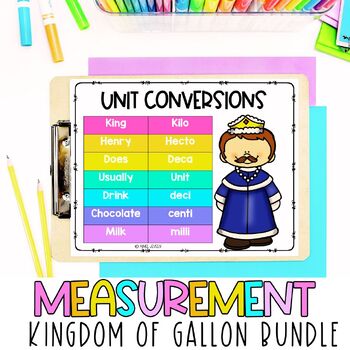Measurement Conversion Activities | BUNDLE | The Kingdom of Gallon Math Activity
- Zip
Products in this Bundle (5)
Bonus
Description
Teach math using this fun story to help students remember liquid measurement conversion. The Kingdom of Gallon is an interactive story that your class will love!
In the Kingdom of Gallon you will find:
4 Queens, 8 Princes, 16 Palace Colts
The members of this kingdom represent:
1 Gallon, 4 quarts, 8, pints, and 16 cups
This product includes:
- A presentation of the Kingdom of Gallon in color and black and white
- A follow-along worksheet for students to take notes
- Printable Posters for your classroom in black and white
- A Mini-Book of the Kingdom of Gallon in color
- A Mini-Book of the Kingdom of Gallon in black and white
- A follow-along worksheet for students to take notes
- 12 worksheets that include:
- Color, black and white options, and answer keys
Additional Resources for this Product:
The Kingdom of Gallon Mini-Books
The Kingdom of Gallon Measurement Worksheets
BONUS FILE:
Metric Measurement Conversions - King Henry Does Usually Drink Chocolate Milk
PERFECT FOR ANY LEARNING FORMAT!
Can be used as a PowerPoint or Google Slides presentation for online and distance learning
Can be printed for in-person classroom use
This product is compatible with Easel and you will receive a PDF version that can be used with Kami (or another online PDF editing platform.)





